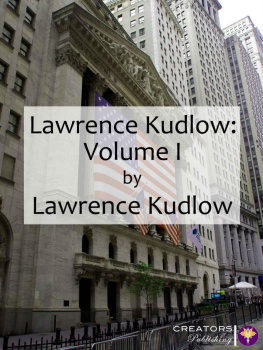Foreword
Lack of space has forced general accounts of American history to ignore most cities and mention the others only in connection with some specific event. Generations of Americans, therefore, have grown up thinking of cities in terms of labels and inaccurate stereotypes. Hartford is inevitably the site of the Hartford Convention, but readers are rarely aware of its more durable role as the insurance center of America. Although writers invariably connect Atlanta with Shermans march to the sea, they almost never explain its great contribution to the rise of the new south after the Civil War. New Bedford is portrayed as a whaling city, while its vital part in American industrial and immigration history is neglected.
So it has been with Lawrence, which appears only because it was the scene of the I.W.W. textile strike of 1912. Terms such as immigrant, labor union, and radicalism have established the image of Lawrence as a slum-ridden city filled with poor immigrant revolutionaries. And since Lawrence is often one of the few immigrant cities that are even mentioned, the readers mind soon leaps to the more dangerous assumption that all immigrants were povertystricken and un-American. This work proposes to find the truth about Lawrence and in the process to discover much about the immigrant in urban America.
Until recently, immigrant studies approached the subject principally from the point of view of this country. As early as the American Revolution, Hector St. John de Crevecoeur was describing the effect of the melting pot on the formation of American nationality. Countless authors followed with glowing accounts of the opportunities that America offered to the poor of Europe. Even when writers began to describe the terrible living conditions of the immigrants in eastern cities, they were more concerned with the impact of these slums on the United States than on what they meant to the new arrival. The work of Marcus Hansen and Oscar Handlin shifted the attention from this country to the immigrant and introduced the problem of immigrant acculturation. But while there have been some recent studies of immigrant cities, none has been carried on down through the great middle period of American immigration history from the Irish potato famine in 1846 to the quota law of 1921. Lawrence has proved an ideal city for such a project. Founded in 1845 as a textile city, its population was so heavily foreign-born that, by 1910, 90 per cent of its people were either first-or second-generation Americans, representing almost every country in the world.
Immigrant City begins with an account of the city as it appeared to most native Americans during the strike of 1912a notorious, penniless, un-American slum. Then follows a narrative of the citys history from 1845 to 1912, which puts the strike in its proper perspective. Throughout this narrative one theme keeps recurringthe immigrants constant search for security in the new worldand consequently the next section is devoted to finding whether the immigrant, from his own point of view, was able to find security. Only after these steps have been taken, does the book return to 1912, and by that time the true meaning of the strike and the city is clear. In sum, Immigrant City attempts to determine whether or not the immigrant found the security for which he was looking and whether he was able to become an American. If he succeeded in these two quests, then life for the foreign-born in America was not as grim as some authors have suggested.
Originally the work was a doctoral dissertation at Harvard under Professor Handlin, but since then it has been completely revised and the documentation drastically reduced. Anyone interested in more tables and more statistics may consult the dissertation copy in the archives of the Harvard College Library. The first two chapters of the dissertation appeared in the October, 1956, issue of the Essex Institute Historical Collections.
The study proved to the authors satisfaction that no immigrant was on his own in America and his research convinced him that no writer does anything alone either. I owe a debt to many, especially Phillips E. Wilson, John B. Heath, and David Tyack, who read portions of the manuscript, George Abdo, who translated issues for three years of an Arabic newspaper, and Edwin Fenton, who was more than generous with materials from Italian newspapers and interviews on the Lawrence strike. Two leaves of absence from the Phillips Exeter Academy made the research and writing possible. The librarians at Widener, Baker, and Littauer libraries at Harvard, the Massachusetts State Library, the Massachusetts Historical Society, the Boston Public Library, the Essex Institute, and the Lawrence Public Library were unstinting in their aid. Publication of this book was assisted by a grant from the American Association for State and Local History, under the terms of its annual manuscript competition. I am much indebted to the staff of The University of North Carolina Press for its careful work in publishing the book. Like so many scholars in the field of immigration the author received most of his inspiration and guidance from Oscar Handlin.
The book is dedicated to my wife Tootie, who did the more important job of bringing up a growing family while the research and writing went on.
DONALD B. COLE
Exeter, New Hampshire
December, 1962
CHAPTER I
The Notorious City, 1912
Victory is in sight. The working class will back you up to a finish in your fight against peonage and starvation. The slave pens of Lawrence, ... are a disgrace to American manhood So wrote Eugene Debs as he sought to encourage the leaders of the Lawrence textile strike in the winter of 1912. The civilization of the Old Bay State is on trial, contended the Brooklyn Eagle. Bill Haywood, leader of the Industrial Workers of the World, who barely had been acquitted from implication in the murder of Governor Steunenberg of Idaho, came to take over the strike. Lincoln Steffens, Samuel Gompers, and Victor Berger watched closely from the sidelines, for peaceful Lawrence was now riot-ridden.For two months the story of the Lawrence strike dominated the front page of The New York Times and all the Boston newspapers. When the I.W.W. newspaper Solidarity offered a special edition devoted to Lawrence, the public bought a record-breaking 12,000 copies. Faneuil Hall, long familiar with revolutionary gatherings, and Carnegie Hall both echoed to the shouts of strident meetings called to raise money for the Lawrence strikers. At Carnegie Hall, Haywood broke into a debate between the anarchist Emma Goldman and the socialist Sol Fieldman to plead for funds. The audience, deeply moved, hurled a torrent of coins and bills onto the floor of the stage. And after the strike was over, interest continued. When the United States Labor Commission issued a report on the strike, copies were so much in demand that they were soon hard to come by.






